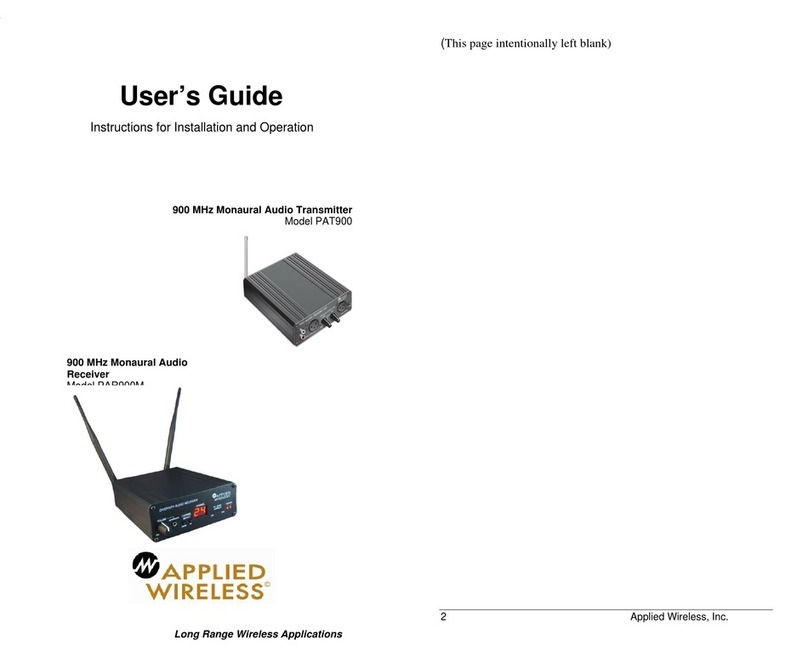User’s Guide – 900MHz Stereo Audio Transmitter & Receiver 15
The following sections pertain exclusively to the Audio
Transmitter, Model AT900-32:
This product incorporates transmitter module FCC ID: QY4265
This device complies with Part 15 of the FCC Rules. Operation is
subject to the following two conditions:
(1) This device may not cause harmful interference and
(2) This device must accept any interference received, including
interference that may cause undesired operation.
INSTRUCTION TO THE USER (required by the FCC)
This equipment has been tested and found to comply with the
limits for a class B digital device, pursuant to part 15 of the FCC
Rules. These limits are designed to provide reasonable protection
against harmful interference in a residential installation. This
equipment generates, uses and can radiate radio frequency energy
and if not installed and used in accordance with the instructions,
may cause harmful interference to radio communications.
However, there is no guarantee that interference will not occur in a
particular installation. If this equipment does cause harmful
interference to radio or television reception, which can be
determined by turning the equipment off and on, the user is
encouraged to try to correct the interference by one or more of the
following measures:
Reorient or relocate the receiving antenna.
Increase the separation between the equipment and
receiver.
Connect the equipment into an outlet on a circuit different
from that to which the receiver is connected.
Consult the dealer or an experienced radio/TV technician
for help.
This equipment has been certified to comply with the limits for a
class B computing device, pursuant to FCC Rules. In order to
maintain compliance with FCC regulations, shielded cables must
be used with this equipment. Operation with non-approved
equipment or unshielded cables is likely to result in interference to
radio and TV reception. The user is cautioned that changes and
modifications made to the equipment without the approval of
manufacturer could void the user’s authority to operate this
equipment.
16 Applied Wireless, Inc.
ONE YEAR LIMITED WARRANTY (USA)
Products manufactured by APPLIED
WIRELESS, INC. (AW) and sold to
purchasers in the USA are warranted by
AW according to the following terms and
conditions. You should read this Warranty
thoroughly.
WHAT IS COVERED,AND DURATION OF
COVERAGE:
AW warrants the product to be free from
defects in materials and workmanship for
one (1) year from the date of purchase by
the original end user purchaser.
WHAT IS NOT COVERED:
This warranty does not apply to the
following:
1. Damage caused by accident,
physical or electrical misuse or
abuse, improper installation, failure to
follow instructions contained in the
User’s Guide, any use contrary to the
product’s intended function,
unauthorized service or alteration
(i.e. service or alteration by anyone
other than AW).
2. Damage occurring during shipment.
3. Damage caused by acts of God,
including without limitation:
earthquake, fire, flood, storms, or
other acts of nature.
4. Damage or malfunction caused by
the intrusion of moisture or other
contamination within the product.
5. Batteries supplied by AW in or for the
product.
6. Cosmetic deterioration of chassis,
cases, or pushbuttons resulting from
wear and tear typical of normal use.
7. Any cost or expense related to
trouble-shooting to determine
whether a malfunction is due to a
defect in the product itself, in the
installation, or any combination
thereof.
8. Any cost or expense related to
repairing or correcting the installation
of an AW product.
9. Any cost or expense related to the
removal or reinstallation of the
product.
10. Any product whose serial number or
date code is altered, defaced,
obliterated, destroyed, or removed.
This warranty is extended to the original
purchaser of the product(s) only, and is
not transferable to any subsequent owner
or owners of the product(s). AW reserves
the right to make changes or
improvements in its products without
incurring any obligation to similarly alter
products previously purchased.
EXCLUSION OF INCIDENTAL OR
CONSEQUENTIAL DAMAGES:
AW expressly disclaims liability for
incidental and consequential damages
caused (or allegedly caused) by the
product. The term “incidental or
consequential damages” refers (but is not
limited) to:
1. Expenses of transporting the product
to AW to obtain service.
2. Loss of use of the product.
3. Loss of the original purchaser’s time.
LIMITATION OF IMPLIED WARRANTIES:
This warranty limits AW’s liability to the
repair or replacement of the product. AW
makes no express warranty of
merchantability or fitness for use. Any
implied warranties, including fitness for
use and merchantability, are limited in
duration to the period of the one (1) year
express limited warranty set forth herein.
The remedies provided under this
warranty are exclusive and in lieu of all
others. AW neither assumes nor
authorizes any person or organization to
make any warranties or assume any
liability in connection with the sale,
installation, or use of this product.
Some states do not allow limitations on
how long an implied warranty lasts, and
some states do not allow the exclusion or
limitation of liability for incidental or
consequential damages so the limitations
or exclusions stated herein may not apply
to you. This warranty gives you specific
legal rights and you may have other rights
which vary from state to state.
(continued on next page)





























